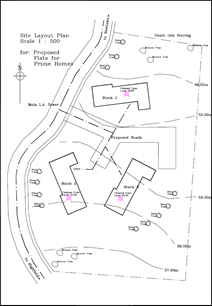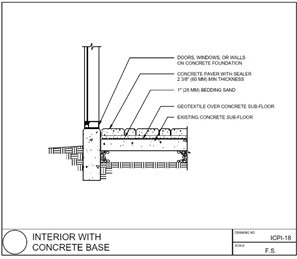In the construction industry, reading and interpreting relevant building and construction documentation is very crucial as it is the foundation that is required to establish project requirements and estimate project costs.
Predicting proper project expenses is one of the most critical aspects of building and construction. Builders and subcontractors need this information in order to make critical judgments about budgets, project viability, and scope of work, while clients require this information in order to determine the suitability and feasibility of the work they want done. Therefore, estimating costs for a project, forms the very foundation for successful planning and execution of a project.
Cost estimation is done by breaking the scope of the project down into manageable parts and using all the information available to arrive at a total expected cost. A costs estimation for a construction project must be as accurate as possible. To develop an accurate cost estimate, the individual responsible for estimating the expenses must analyse all aspects and anticipated costs of the project.
It is critical to always discuss and double-check with the customer that the scope of work and expectations are clearly stated in the plans and specifications, and all details are recorded. If insufficient documentation is provided for a construction project, inaccurate estimates may be presented, resulting in the job going over budget and schedule, causing problems for all parties involved.
A list of relevant and common documents and an explanation of what each one contains is provided in the table below:
|
Type of document |
What it contains |
|
Contract (Agreement to build) |
It is a formal agreement between the construction/building contractor and the client. It sets the scope and terms and conditions of the project. |
|
Statutory requirements / state laws and regulations |
These include documents such as WHS laws, building and construction codes , state laws , local council requirements, permits, environmental protection act and regulations the work must conform to all these requirements and costs are estimated based on the this. |
|
Plans and drawings |
A construction drawing is a document that regularly refers to a detailed graphic representation of what needs to be constructed construction plans are the blueprints that detail the finalised information. |
|
Specifications |
This documents outlines administrative and procedural requirements relevant to the work. |
|
Costs estimate |
This document covers all project related costs such as labour costs, workers insurance costs , site costs , transportation and delivery charges, costs of hiring sub-contractors etc. |
|
Schedule of quantities |
This document includes list of various materials and costs of hiring equipment to carry out tasks. |
|
General condition report |
This includes documents such as soil report, engineers report, providing recommendation on any challenges involved with the site. |
|
Schedule of estimated allowance |
This document lists provision for estimated items whose price may be unknown at the time of the contract. |
|
Project schedule |
This document lists all the tasks that need to be completed under the obligations of the contract within agreed timeframe i.e. time and date of completion of each of the tasks. |

Read and interpret plans and specifications
The first documents you will be receiving in a construction project are the construction drawings and specifications. These documents tell the builder what to build and how to build the project. However, building and construction regulations, codes, and standards set the minimum technical requirements of how a building needs to be constructed. These requirements include what materials to use, how the construction should be done, and what elements should be present at the site of construction. With the construction drawings and specifications, you have all the information you need to identify the resources required to complete the construction project.
Read and interpret construction drawings and specifications
Construction drawings and specifications are documents used in construction that tell a builder exactly how a building is to be made, including dimensions, detailing, the arrangement of components, what building materials to use, and so on. Construction drawings are graphical representations of the building to be constructed, while specifications provide the details of the products, materials, and work necessary to complete the construction project.
There are many types of construction drawings that give the builder different graphical information about the building to be constructed. Examples of construction drawings include:
|
Shows the layout of the rooms in a building
|
|
|
Site plans |
Shows the building site's features including its surrounding areas |
|
Elevation drawings |
Shows the exterior faces of the building as seen from a particular direction, usually north, south, east and west |
|
Section drawings |
Shows the building as if it had been sliced in half along an imaginary plane |
|
Detail drawings |
Provides a detailed description of some part of the building including information about assembly |
To interpret these drawings, you will need to understand what the symbols on them mean. Some common symbols used in such drawings include the following:
|
Symbol |
Meaning |
Symbol |
Meaning |
|
|
Single switched wall socket |
|
Adjustable recessed spotlight |
|
|
Double switched wall socket |
|
Recessed spotlight |
|
|
Double switched wall socket above work-top level |
|
Wall light |
|
|
Single switch fused spur |
|
Telephone point |
|
|
TV aerial |
|
Consumer unit |
|
|
One gang light switch |
|
Shaver socket |
|
|
Two-gang light switch |
|
Ethernet socket |
|
|
Two-gang two-way light switch |
|
Thermostat |
|
|
Dimmer switch |
|
Lamp |
|
|
Pendant light |
|
Passive vent |
|
Symbol |
Meaning |
Symbol |
Meaning |
|
|
North point |
|
Brick |
|
|
Wash basin |
|
Stonework |
|
|
Sink |
|
Sand |
|
|
Bath |
|
Stone |
|
|
Shower tray |
|
Rubble |
|
|
Water closet |
|
Insulation |
|
|
Water outlet |
|
Sawn timber |
|
|
Soil vent pipe |
|
Hardwood |
|
|
Boiler flue |
|
Plywood |
|
|
Blockwork |
|
Door |
Example
John is in charge of identifying and producing the estimated costs for the project with the following details:
- House Plan: Design For Place, Commonwealth Government
- Project Manager: Self-managed by owner
- Size: 194m2
- Size of land: 1.5 acres

Passive heating and cooling
A significant element in passive heating and cooling is internal thermal mass. Through the house's release and absorption of heat, internal temperatures are stabilised, and comfortable temperatures are maintained during winter and summer.
The concept of internal thermal mass is applied to the house through:
- Reverse brick veneer in the east and west external bedroom walls
- Rammed earth walls between the living room and bedroom 1 and 2
- Concrete floors throughout the house
Special stone/hardwood floor panels to insulate the concrete slab are also added to aid these design features. The floor panels maintain thermal conductivity whilst giving the look and feel of wooden floors. The living room walls have been upgraded from brick to rammed earth for the aesthetic feature and slightly denser thermal mass.
The sun enters the house through the northern windows during winter to charge the internal thermal mass with slow-release heat. The eaves block the sun from direct access into the house during summer. Overnight cross-flow ventilation was kept in mind when decided the placement of openable windows to remove the build-up of summer heat. The transfer of heat from inside to outside is prevented by thermally broken double-glazed windows and sliding doors.
John identifies that the project details describe a 194m2 house built on 1.5 acres of land. The floor plan shows that the house entrance is facing eastwards, as indicated by the compass marker on the top right part of the plan pointing north. There are three bedrooms, two bathrooms, a laundry room, and a pantry room. The living room, dining room, and kitchen will be in one big open space in the middle of the house. To regulate the temperature inside the house, a reverse brick veneer will be applied to the east and west external bedroom walls, rammed earth walls will be installed between the living room and bedrooms 1 and 2, and concrete floors will be used throughout the house.
Building and construction regulations, codes, and standards
In addition to the information on the construction drawings and specifications, you must also keep in mind that the project will need to comply with several building and construction regulations, codes, and standards.
Some regulations only apply to specific states/territories, so it is essential to check what building and construction regulation applies to a construction project with your jurisdiction's building administration.
National Construction Code (NCC)
The National Construction Code is the statutory reference for the minimum technical requirements for the design, construction, and performance of all new buildings and plumbing and drainage systems in Australia. It is made up of three volumes, with Volumes One and Two together forming the Building Code of Australia (BCA). Each volume contains the following:
- Volume One contains the requirements for buildings that are multi-residential, commercial, industrial or public, and;
- Volume Two contains the requirements for buildings and structures that are residential or non-habitable, and;
- Volume Three contains the requirements for plumbing and drainage for all classes of buildings.
A building's compliance with the NCC is dependent on whether it satisfies the General and relevant Performance Requirements specified in the NCC.
General Requirements provide rules and instructions on applying the NCC to a construction project. Performance Requirements are the requirements of the NCC that must be met. It constitutes the minimum level that buildings and building elements must meet.
Because of the NCC's performance-based nature, a choice of compliance pathways is opened for a construction project to comply with the NCC. A project may adopt either the Performance Solution or the Deemed-to-Satisfy (DTS) Solution. When a building complies with the NCC by using Assessment Methods provided in the NCC, this is called a Performance Solution. On the other hand, a DTS Solution follows the set recipe of what, when, and how to do something as prescribed in the NCC.
Here is a video that you can watch on NCC performance code:
The NCC: A performance based code video was provided by the Australian Building Codes Board © 2021 under the CC BY ND licence. Original content hosted abcb.gov.au/resources
Building and construction industry standards
Standards are specifications and procedures that have been set out by particular organisations so that processes, systems, and services are consistent and reliable. Standards are often used in legislation to provide a baseline of what is considered safe. In building and construction, standards are referenced by the NCC and some codes of practice to ensure the consistency or safety of the building being constructed and the construction workers. You must remember that while legislation may enforce standards, the standards themselves are not legally binding. Standards only begin to hold legal weight when they are enforced by legislation.
Examples of standards in the building and construction industry include the following:
AS3959: Establishes the bushfire attack levels used to establish the requirements for construction
- Bushfire attack levels: BAL Low, BAL 12.5, BAL 19, BAL 29, BAL 40, BAL FZ
AS/NZ 4020: Prescribes methods of testing products that come into contact with drinking water
- Prescribed methods of testing: taste of water; appearance of water; ability of product to support the growth of aquatic micro-organisms; cytotoxic activity of water testing; mutagenic activity of water extract; extraction of metals
Environmental Protection Authority (EPA) Regulations
The Environmental Protection Authority is an independent statutory body delegated to protect the environment and prevent and control environmental harm. They oversee enforcing regulations with an environmental concern.
EPA regulations are State/Territory-specific; therefore, you must consult the state/territory EPA branch in your jurisdiction to determine which policy and regulation apply to your construction project. For example, here are the policies and regulations enforced by the EPA in Victoria:
- Environment Protection Act 1970
- Environment Protection Act 2017
- National Environment Protection Council (Victoria) Act 1995
- Pollution of Waters by Oil and Noxious Substances 1986
Along with the construction project's location, the workplace procedures of your organisation will serve as the basis for compliance with environmental requirements. Workplace procedures are specific instructions on what an organisation's employee should do to carry out particular tasks. In building and construction, specific tasks refer to the construction works of a construction project. For example, in Victoria, should workplace procedure specify the use of an earthmoving plant for particular construction works, compliance with the Environment Protection Act 1970 must be ensured.
There are a variety of environmental legislation in Australia. You can find a list of legislation on the Department of the Agriculture, Water and the Environment’s website. Environment-related regulations vary from state to state, so always make sure you are aware of the relevant state/territory regulation.
Work Health and Safety Act (WHS Act) in Building and Construction
The building and construction work environment can be hazardous and is paired with occupational risks. The Work Health and Safety (WHS) Act defines strict health and safety requirements for the protection of all workers at work and other people who might be affected by the work. It is the legal obligation or duty of everyone to adhere to these requirements.
Compliance with WHS requirements will be dependent on the workplace procedures of the construction project. Furthermore, while it is everyone's legal obligation to adhere to WHS requirements, the construction site's person-in-charge is responsible for ensuring that all workers follow the requirements. This may be done using signs to communicate what safety requirements apply to which area of the construction site or through the provision of certain site facilities.
All state/territories observe the WHS Act because it is Commonwealth law. However, State/Territory-specific WHS regulations are also enforced in each state/territory. These regulations are consistent with the WHS Act; however, some WHS requirements may differ in each state/territory.
The WHS legislation for each per state and /territory and the corresponding regulators are shown in the table.
|
State/Territory |
WHS Legislation |
WHS Regulator |
|
Australian Capital Territory |
||
|
New South Wales |
||
|
Northern Territory |
Work Health and Safety (National Uniform Legislation) Act 2011 |
|
|
Queensland |
||
|
South Australia |
||
|
Tasmania |
||
|
Victoria |
||
|
Western Australia |
State/Territory-specific Building and Construction Regulations
As previously mentioned, some building and construction regulations are specific to the state/territory where the construction project will be located, in addition to the NCC that must be complied with by all new buildings throughout Australia. For example, the Building Act 2011 of Western Australia specifies regulations for all Western Australia territory buildings. This specific regulation only applies to Western Australia's territory and will not apply to buildings in other states/territories.
For example, a construction project located in Victoria will have to comply with building and construction regulations enforced in Victoria and the NCC. These regulations include the Occupational Health and Safety Regulations 2017, Environment Protection Act 1970, Environment Protection 2017, and other EPA regulations enforced in the jurisdiction.The Australian Business License and Information Service (ABLIS) website has a convenient tool that lets you search what compliance requirements are needed by your business. You can use this tool to check what regulations your construction needs to comply with. .
You can see some of the acts and regulations in each state and territory relevant to different building classifications in the table.
|
State/Territory |
Act |
Regulations |
|
Australian Capital Territory |
||
|
New South Wales |
||
|
Northern Territory |
||
|
Queensland |
||
|
South Australia |
Planning, Development and Infrastructure Act 2016 (SA) |
Planning, Development and Infrastructure (General) Regulations 2017 (SA) |
|
Tasmania |
||
|
Victoria |
||
|
Western Australia |

The construction drawings and specifications should ideally contain all the information a contractor needs to finish a construction project. Therefore, after reading and interpreting the construction drawings and specifications of a project, you must now be able to identify the building site features, type of building, method of construction, and specified building materials necessary for the completion of the project. Identifying these is important in producing the estimated cost of a construction project. The building site features, type of building, construction method, and specified building materials will serve as the basis for many of what needs to be identified later on, such as the number of required materials and the and physical resources required for the project.
Identify building site features and type of building
By looking at the construction project's site plan, you can determine the site's features where the construction will take place. From here, you should be able to identify the boundaries of the site, the site's location in relation to its surroundings, the main elements of the landscape and so on. Identifying the building site's features will help determine which regulations the project will need to comply with later.
The type of building can also be identified by looking at the construction drawings and specifications. You should determine whether the building to be made is for commercial or residential use, which means identifying what class the building is according to the BCA. Different building classes follow different statutory requirements; therefore, it is important to identify what type of building or structure is to be built as this will determine which regulation, code, and standard the contractor will have to comply with.

Example
The site plan above shows that the building site will be located right next to a highway. There are 12 small trees and six nature trees in the site. The curved lines marked (from the bottom of the image going up) 57.00m, 56.00m, 55.0m, 55.0m, and 56.0m represent the building site's elevated parts.
The building shown in the floor plan to the right can be identified as a Class 1a building as it is a single dwelling that is a detached house.
Identify method of construction and specified building materials
The method of construction and building materials are demonstrated via the construction drawings and further explained by the specifications. The reason for the inclusion of these details is to show that the building is compliant with regulations and other building requirements. These details ensure that the client is safe against legal issues that the construction project might face in terms of NCC compliance.
As a cost estimator, you use these details to identify what resources to consider when producing an estimated project cost. By identifying the method of construction and specified building materials, you can identify the requirements of a project, including the resources needed to perform the established methods and the building materials themselves.
An example of a construction drawing where you might find the methods of construction and specified building materials is the detail drawing of a construction project. For example, you can tell that specified building materials for a construction project include concrete, concrete paver, bedding sand, and geotextile from the detail drawing on the right. The drawing also shows how these building materials should be put together. For example, the geotextile should be placed over an existing concrete sub-floor.

Under section 20 of the Work Health and Safety (WHS) Act 2011, it is stipulated that the person with management or control of a workplace must ensure, so far as is reasonably practicable, that the workplace, the means of entering and exiting the workplace and anything arising from the workplace are without risks to the health and safety of any person.
Because it is the contractor's responsibility to manage workplace risks, the cost for complying with these requirements must also be considered. You have identified the features of the building site and its surrounding areas in the previous section. For this section, you will also have to establish the workplace procedures of your organisation. As discussed in an earlier section, workplace procedures are specific courses of action that a worker in an organisation must take to accomplish a given task. The site features and workplace procedures establish what facilities for the workers are required by the site, the temporary boundary fencing that should be put around it, and the communication requirements needed for the project's duration.
Establish site facility requirements
In order to comply with the WHS Act 2011, a person in charge of a construction worksite should provide adequate and accessible facilities to workers. These facilities include toilets, drinking water, washing facilities, and eating facilities. The following matters should be considered to determine adequate facilities:
i. The size, location, and nature of the construction site.
ii. The number, as well as the composition, of the workers at the construction site.
iii. The nature of the construction works being done.
iv. The availability of power and services.
An example of an adequate facility set up in a construction site is changing rooms for when workplace procedures specify that workers at the site should change in and out of personal protective equipment (PPE).
Establish communication and temporary boundary fencing requirements
The person in charge of a construction site is responsible for any injury occurring due to unauthorised access. For this reason, temporary boundary fencing is put up around the vicinity of a construction site.
The Work Health and Safety Code of Practice for Construction Work contains practices that can be followed in a construction project to control risks in a construction site, including using 'keep out' signs and fencing off excavation sites to keep unauthorised personnel from entering restricted areas.
Temporary boundary fencing restricts access to the site from unauthorised personnel, help secure and contain building materials and equipment, and prevent construction activities from affecting nearby areas.
AS 4687 describes the standards for constructing and installing temporary fencing to protect the public and workers on site. Some temporary boundary fencing requirements may vary between states/territories. For example, in Victoria, construction sites' security fences must be at least 1.8 metres high and proven to be well-constructed, stable, and difficult to access both from climbing and from crawling underneath.
Construction projects require effective communication to ensure the coordination of all construction activities from planning to the finished building delivery. This necessitates the use of different communication tools. Your construction project may need handheld transceivers (better known as walkie talkies) to coordinate workers in the construction site or company phones to ensure convenient and prompt communication with suppliers and sub-contractors. Your project may also need signs around the construction site to ensure workers' safety and comply with work health and safety requirements. All these communication tools comprise the communication requirements of your construction project.

With the specified building materials and method of construction identified, you must now identify how to dispose of waste materials resulting from the project's construction activity. The Environmental Protection Agency regulates the disposal of construction waste. Certain types of waste must be disposed of in the appropriate facility. For example, the EPA specifies certified landfills where domestic and commercial asbestos may be safely disposed of. Disposal of asbestos anywhere that cannot lawfully accept it will result in a violation with a fine of more than $7500, or up to 5000 penalty units if prosecuted.
Waste from construction activities should be disposed of in waste management sites. These sites impose waste disposal fees depending on the waste material that is being disposed of there. Upon identifying the waste removal requirements that a construction project must comply with; you must also determine the waste management sites where the waste materials will be disposed of and inquire about their waste disposal fees.
After identifying the building site features, type of building, method of construction, building materials, and all the requirements the construction project must comply with, you should now identify the different statutory, approvals, or compliance costs that apply to the construction project. Statutory, approvals, or compliance costs may come from various sources, such as permit applications and fees. To identify what these costs are, you will need to refer to the building and construction regulations that the construction project must comply with or inquire at your jurisdiction's building administration.
For example, suppose a construction project in Victoria needs works approval from EPA to comply with one of their enforced regulations. In that case, the person in charge of the construction project will have to pay an application of either:
i. 1 % of the total estimated cost of capital works in a works approval, or;
ii. $1,212;
whichever is greater, with a maximum fee of $66,645.























